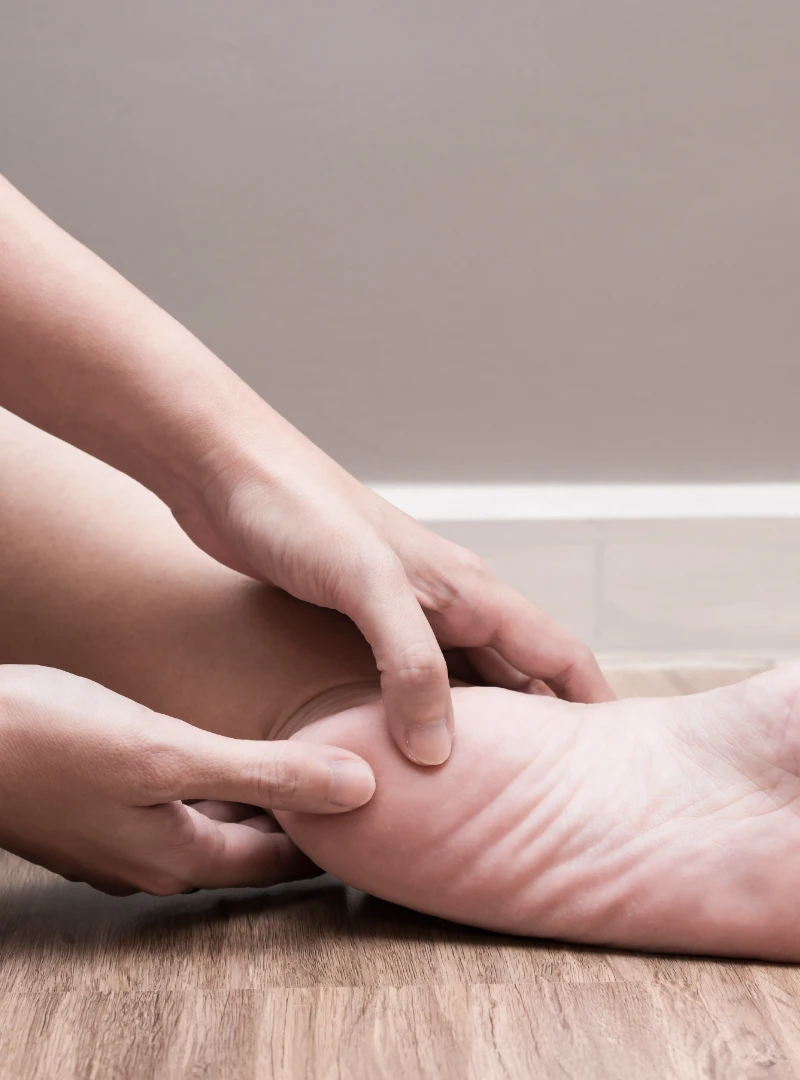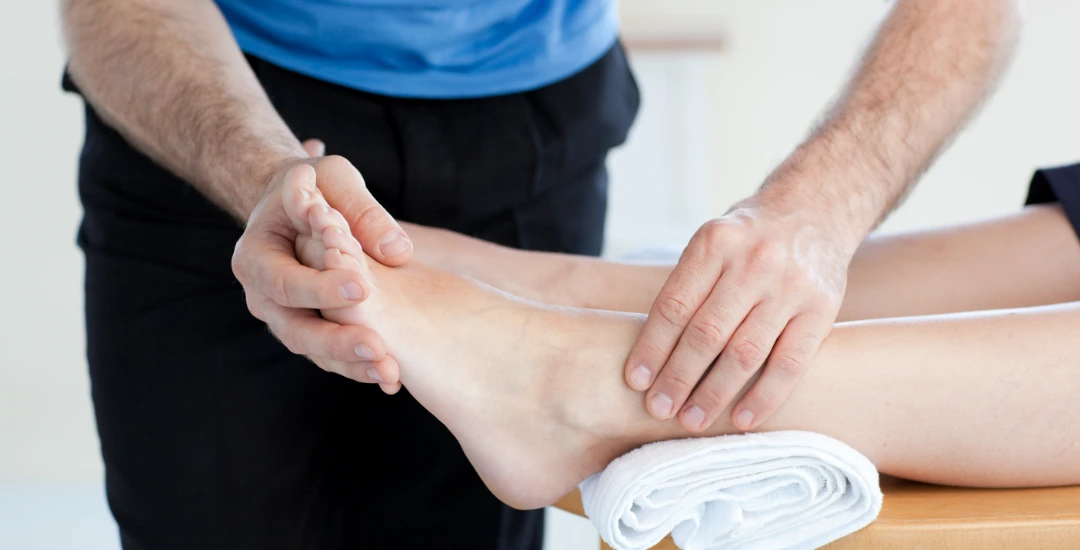Plantar
Fasciitis
- Home
- Conditions We Treat
- Foot & Ankle
- Plantar Fasciitis

What is
plantar fasciitis?
Plantar fasciitis is one of the most common heel pains that is characterised by inflammation of the plantar fascia, which is a stretchy band of tissue that connects your heel bone to the base of your toes. Patients have described the pain as similar to stabbing pain that typically occurs in the morning. The pain tends to dissipate when mobile but may return after sitting or standing continuously.
What causes plantar fasciitis?
Plantar fasciitis is primarily caused by repetitive strain that leads to microtears in the plantar fascia. This strain occurs due to various conditions that affect the biomechanics of the foot such as:
- Pes planus (Flat feet): flat feet increase strain on the origin of the plantar fascia, especially where it connects to the heel– leading to overstretching and tearing.
- Pes cavus (High arches): with high arches, the foot’s ability to absorb shock is reduced. This causes excessive strain on the heel as the foot is less flexible and does not effectively resist or adapt to ground forces.
- Limited ankle dorsiflexion: tightness in the ankle muscles (gastrocnemius and soleus) can limit upward foot movement, forcing the plantar fascia to overcompensate– leading to strain and degeneration.
- Excessive foot pronation or supination: both excessive inward rolling (pronation) and outward rolling (supination) of the foot during walking can cause abnormal stretching or compression of the plantar fascia, contributing to injury.
Additionally, these factors combined with prolonged standing, running, walking or jumping will result in the overstretching of the plantar fascia. This gradually causes degeneration, with microtears accumulating due to constant strain. Eventually, this results in chronic degeneration and the onset of plantar fasciitis symptoms.
Who is at risk of developing plantar fasciitis in Singapore?
Considering the fact that plantar fasciitis is a common orthopaedic condition, certain risk factors will increase one’s likelihood of developing plantar fasciitis such as;
- Age: common among working adults between the ages of 40 and 60 years old.
- Athletes: plantar fasciitis is more common amongst athletes, particularly runners due to exerting excessive pressure and weight on the plantar fascia. If you frequently exercise on hard, flat surfaces or engage in sports such as ballet dancing and tennis, you too have an increased risk of developing plantar fasciitis.
- Certain occupations: if you have a job that demands you to be on your feet for an extended time, especially on hard surfaces, then you have a higher risk of developing plantar fasciitis.
- Foot mechanics: if you have a high arch, flat feet or an atypical walking pattern, then your chances of developing plantar fasciitis are higher due to the poor weight distribution.
- Obesity: obesity makes you more prone to plantar fasciitis as the extra weight adds extra pressure on your plantar fascia.
- Poor footwear: regularly wearing poor footwear that offers little to no cushioning or support contributes to the likelihood of developing plantar fasciitis.
- Tight calf muscles: if you have tight calf muscles, then your chances of developing plantar fasciitis increase.

What are the symptoms of plantar fasciitis?
You are likely to be suffering from plantar fasciitis if you have some of the following symptoms:
- A stabbing pain in the bottom of the foot, particularly near the heel.
- A tight Achilles tendon.
- Pain in the arch of the feet.
- Pain in the heels.
- Stiffness in the feet.
- Swelling around the heels.How are plantar fasciitis diagnosed in Singapore?
How are plantar fasciitis diagnosed in Singapore?
Diagnosing plantar fasciitis is a simple procedure that entails the following steps:
- Physical examination: the diagnostic procedure will begin with a physical examination to examine the foot for any redness, tenderness, swelling, and pain. During the examination, you may be required to flex your foot to gauge the severity of the pain and assess muscle strength, reflexes and nerve function.
- Imaging testing: if necessary, imaging tests may be recommended. Some of these include;
- X-rays: X-rays are used to rule out fractures, heel spurs and any other bone-related issues that might be causing your symptoms.
- Magnetic resonance imaging (MRI): MRIs help detect the thickening of the plantar fascia, any swelling or other tissue-related concerns.
- Ultrasound: an ultrasound is employed to identify any classifications, thickening or any other additional tissue-related concerns of the foot.

How are plantar fasciitis treated in Singapore?
Once a diagnosis has been confirmed, your orthopaedic specialist will propose a treatment plan to alleviate your symptoms and improve your condition. At Cove Orthopaedic, we offer the following treatments:
- Oral medications: such as NSAIDs (nonsteroidal anti-inflammatory drugs) may be prescribed to help reduce pain and inflammation.
Injections: such as cortisone injections are often recommended due to their powerful anti-inflammatory property. Additionally, patelet-rich plasma (PRP) injections may also be prescribed to promote healing in the plantar fascia as it lowers the risks of tendon ruptures.
- Physical therapy: if deemed necessary, you will be recommended to undergo physical therapy that is intended to strengthen the lower leg muscles.
- Shock Wave Therapy (EPAT): EPAT uses acoustic waves to promote blood flow, and healing in the plantar fascia.
- Immobilisation: immobilisation refers to a walking boot or cast that is used to relieve pressure off the plantar fascia, thereby encouraging recovery.
- Night splints: night splints are used to keep the plantar fascia, and Achilles tendon stretched while sleeping to encourage healing.
- Orthotics: orthotics are customisable arch supports to ensure the pressure is evenly distributed throughout the sole of your feet.
- Supportive Shoes: supportive shoes are customised with built-in arch support to reduce strain on the plantar fascia.
- Ultrasonic tissue repair: ultrasonic tissue repair is a non-invasive therapy that uses sound waves to break up damaged tissues and encourage new tissues to grow.
- Surgery: such as gastrocnemius recession is designed to lengthen the calf muscle. In doing so, it helps to reduce pressure on the plantar fascia– subsequently improving foot flexibility. A surgery namely, plantar fascial release, could also be recommended to relieve tension-associated pain. Surgery is often the last resort and reserved for patients with chronic plantar fasciitis.


At Cove Orthopaedic, we strive to offer comprehensive treatment and care to improve your quality of life. If you have been experiencing heel pain or struggle with reduced quality of life due to your foot health, contact us to schedule a consultation and address your concerns promptly.
Frequently asked questions
How long does plantar fasciitis last?
It takes approximately a couple of weeks to a few months for plantar fasciitis to heal.
Are plantar fasciitis and heel spurs similar?
No, they are not similar. The differences are:
- Plantar fasciitis: plantar fasciitis results in pain in the heel due to tight or strained plantar fascia.
- Heel spur: a heel spur, on the other hand, is a bony protrusion on the underside of the heel bone.
How can I prevent plantar fasciitis?
Some of the preventive measures that you can consider are:
- Avoid overusing or overexerting your foot.
- Wearing well-fitted shoes that offer ample cushioning and support.
- Stretch out the muscles before engaging in any exercises or sports.
What are the potential complications of plantar fasciitis if I delay treatment?
By delaying treatment, you risk experiencing some of the following complications:
- Chronic heel pain.
- Problems with your back, hip, knee or foot due to changes in your walking pattern or poor weight distribution.’
- Reduction of quality of life due to impeded mobility.










